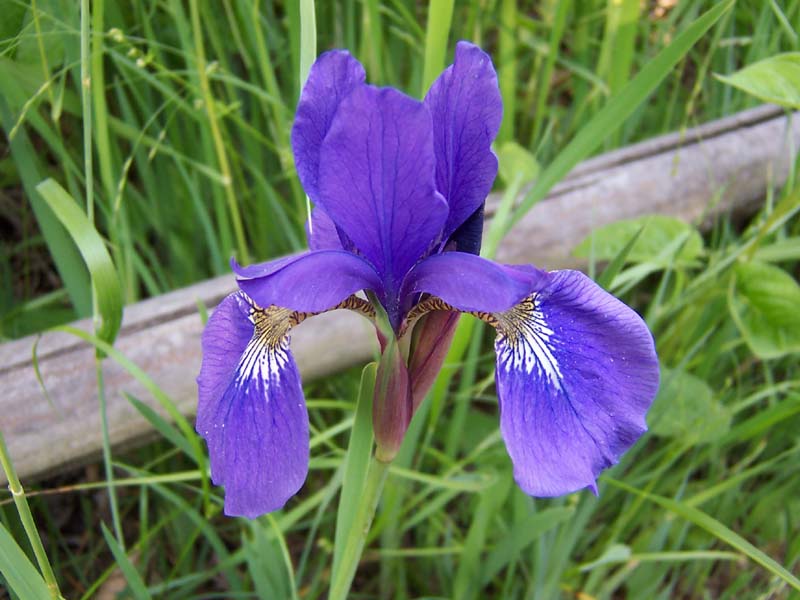
Blood Iris Facts
- This gorgeous product of Nature and evolution most frequently goes by the surprising common name of the Blood Iris. The marvelous flora has at least one other, less often used general title, though. That’s the quite similar appellation of blood-red iris.
- Within the scientific community, however, it’s perhaps better known by its technical designation. Fortunately for the layperson, that’s a comparatively simple honorific to pronounce. That’s because the species holds the formal moniker of Iris sanguinea.
- It received that epithet due to the combined efforts of two men. British botanist James Donn and Danish botanist Jens Wilken Hornemann accomplished the first recognition of it as a separate and distinct species. That noteworthy event occurred in 1811.
- Thankfully, the remarkable Blood Iris appears to be maintaining a population base that’s both stable and sufficient. That pleasant state further seems to hold true across its native range. The IUCN thus presently has no listing for the plant on its Red List.
- The botanical wonder nevertheless should be considered to be facing several potential threats to its existence, at least. Most of these stem from the actions of humans. They include such perils as habitat loss and degradation, and, of course, climate change.
Related Articles
Blood Iris Physical Description
The stunning Blood Iris quickly captures the attention of most individuals who view it. This marvelous Angiosperm typically does so, though, due more to its pure beauty than sheer size. That’s true since it qualifies as approximately average-sized for its kind.
Each individual specimen produces a single, unbranched stem. This generally develops as relatively thin and upright, though sufficiently sturdy enough to support its weight. This part of the amazing flora attains a mean height ranging from 12 – 35.5 in (30 – 90 cm).
Intriguingly, the leaves grow to roughly the same length as the height of the stems. This very distinctive foliage tends to droop somewhat, however, seeming shorter. Each slim leaf also varies from 7.9 – 23.6 in (20 – 60 cm) in length, and 0.2 – 0.5 in (0.5 – 1.3 cm) in width.
The stem, which evolved as hollow in nature, also shares a trait with the leaves of the plant. That pertains to their color. Both parts of this member of its Order present a light green shade. The foliage, though, sometimes appears a slightly darker hue than the stem.
Yet, it’s the flowers of the Blood Iris that generally garner the most attention. That’s fully understandable, due to their great beauty. Each has six petals. The three outer one’s, called sepals, droop downward. But the inner three, named tepals, remain relatively vertical.
The basic background color of these smooth, lacy petals comes in different shades, due to the existence of several varieties. These range from a dark blue to bluish-purple, to a strong red-violet. Amazingly, however, white variants do appear on range occasions.
- Kingdom: Plantae
- Phylum: Tracheophytes
- Class: Monocots
- Order: Asparagales
- Family: Iridaceae
- Genus: Iris
- Species: I. sanguinea
Blood Iris Distribution, Habitat, and Ecology
The mesmerizing Blood Iris evolved as native to a moderately broad stretch of the earth’s surface. That precise zone of habitation might surprise some people, though. That’s true since it developed as endemic to a specific portion of what’s now the continent of Asia.
Within that greater territory, however, it only appears in a certain section. It lives in part of Russia, east of Lake Baikal. From there, its range extends through parts of that country, into Mongolia, five provinces of China, three islands of Japan, and parts of the Korean Peninsula.
Even inside of that larger overall area, the fascinating flora displays decidedly strong preferences regarding its choice of habitat. The botanical wonder only makes its presence known in regions with a temperate climate. This obviously limits its possibilities.
It principally grows natively in such ecosystems as damp meadows, around the peripheries of forests, and along the edges of lakes and rivers. The plant also displays a very precise need pertaining to altitude. Virtually all wild groupings develop at heights around 1,640 ft (500 m).
The splendorous Blood Iris evolved as a beautiful flowering plant possessing a rhizome. In order for photosynthesis and blooming to occur, however, it requires abundant light. That blossoming typically occurs between late spring and early summer in most regions.
The botanical beauty also achieves pollination via the actions of a multitude of locally present insect species. Most commonly, this includes various species of bee. It’s also mildly toxic, like many irises. Among humans, though, ingestion usually only causes vomiting.
Species Sharing Its Range
Check out our other articles on 7 Breathtaking East Coast Wonders, Eurasian Brown Bear, Okefenokee Swamp, Lime Butterfly, Fire Salamander, Lau Banded Iguana, Shoebill, Green Iguana
